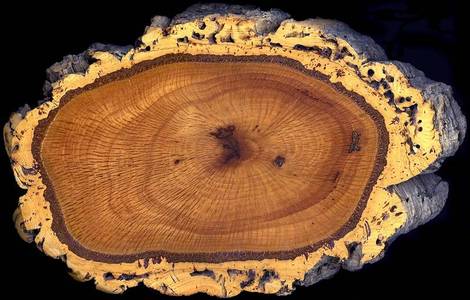cork

Cork oak section.
Cork is a protective, waterproof layer of dead cells that have thick walls impregnated with suberin, a waxy material. Cork is found as the outer layer of stems and roots of older woody plants. The cork oak (Quercus suber) of southern Europe and North Africa produces a profuse amount of cork which is harvested commercially every 3 to 4 years.
The first records of the use of cork are found in Greek writings that mention its use as fish-net floats. Since this time, cork has served mankind in numerous ways and the demand for it has increased despite many advances in the field of plastics.
As it is a natural material formed by a growing tree, cork is composed of cells – minute compartments each bounded by tough waterproof and elastic walls. Every cubic centimeter of cork contains about 40 million of these tiny cells.
The importance of cork arises from its elastic cellular structure which gives it properties unknown in other materials. It is impossible to produce such an elaborate structure artificially. Expanded polystyrene is an artificial cellular material but the spaces are far larger than in cork. The tiny cells contain nothing but air and this feature gives cork its extreme lightness (its specific gravity is about 0.2). When cork is squeezed, it is the air in the cells that is compressed, and the cork quickly returns to its normal volume when the pressure is released. Cork is therefore a very resilient material, with excellent cushioning ability.
Cork cells are tightly packed and, because of this, cork will not let liquids or gases pass through. It is thus the ideal material for use as stoppers and for sealing joints. Cork is resistant to many organic substances and is an efficient seal against gasoline and oil. There is, however, one important reservation to be made about the penetration of liquids. Natural cork is traversed by a number of small pores (lenticels) that allow the inner cells of the bark to "breathe". To prevent evaporation or seepage, bottle corks are always cut so that the pores run across them.
The cellular structure makes cork an ideal material for insulation against sound and vibration. The cushioning effect is so great that large machinery can be erected on cork pads and run without transmitting vibrations to the rest of the building. Similarly, precision machines can be cushioned against incoming vibrations.
A vacuum is the most efficient insulator for a hot or cold body. It is not always possible to use a vacuum, however, and the next best thing is a lining of cork. The cork material itself is a poor conductor of heat and so is the air in the cells. Because the air is confined to these tiny cells it cannot circulate and there is therefore no great convection of heat. Cork does not absorb water like so many other insulating materials (e.g., felt), and is unaffected by many chemicals. This makes it even more useful.
As well as its structural properties cork has useful chemical properties. The most characteristic and common constituent is suberin – a complex mixture of esters and organic acids. This, together with some less common waxy materials, is deposited in the cell walls. These substances are very resistant to chemical action and cork can be used as a stopper for a very wide range of chemicals. Cork is also tasteless and does not affect even the most delicate wines. The tough cell walls render cork virtually insect-proof. It is also very difficult to burn and there is little fire-hazard. This is an important point with insulating materials.
The cellular structure of cork makes it a very valuable material for a wide range of uses. So-called composition cork or cork agglomerate is made from natural cork that has been shredded into small pieces. The size of the pieces depends upon the grade of agglomerate required. Although the cork is shredded, the cellular structure is not destroyed, for each cork fragment still contains thousands of tiny cells. The shredded cork goes into a mold and is heated until the natural resins and other compounds are liquefied and begin to run out. The molds are then cooled and the resins bind the cork fragments together. This sort of material has been used extensively for insulation boarding, for oil-proof gaskets, and for placing underneath heavy machinery.
Cork cambium
Cork cambium is the lateral meristem that forms the periderm, producing cork (phellum) toward the surface (outside) of the plant and phelloderm toward the inside. Cork cambium is common in stems and roots of gymnosperms and dicotyledons.
Production of cork
Cork is formed to some extent in the bark of all trees. However, the cork oak tree (Quercus suber) is the main source of commercial cork. Its cork-producing tissues continue to grow year after year and can build up a considerable thickness of cork. After the cells are formed, the corky substances are deposited in the walls and the cells then die. The cell liquids are withdrawn as the walls thicken. Cork cells then contain nothing but air.
The cork oak grows around the Mediterranean area but production is most intense in Portugal where there are large plantations. The first cork is removed when the tree is about 20 years old. This is virgin cork and is of low quality and very furrowed. A stripped tree begins to form new cork quite quickly – about an eighth of an inch per year. Trees are usually stripped once every nine years. Cork thickness os about one inch is obtained each time. The second and subsequent strips are called cultivated cork. They are fairly smooth and uniform but after about 80 years the quality falls. Before the cork is used it is usually boiled for an hour or two. This removes much of the tannin.


